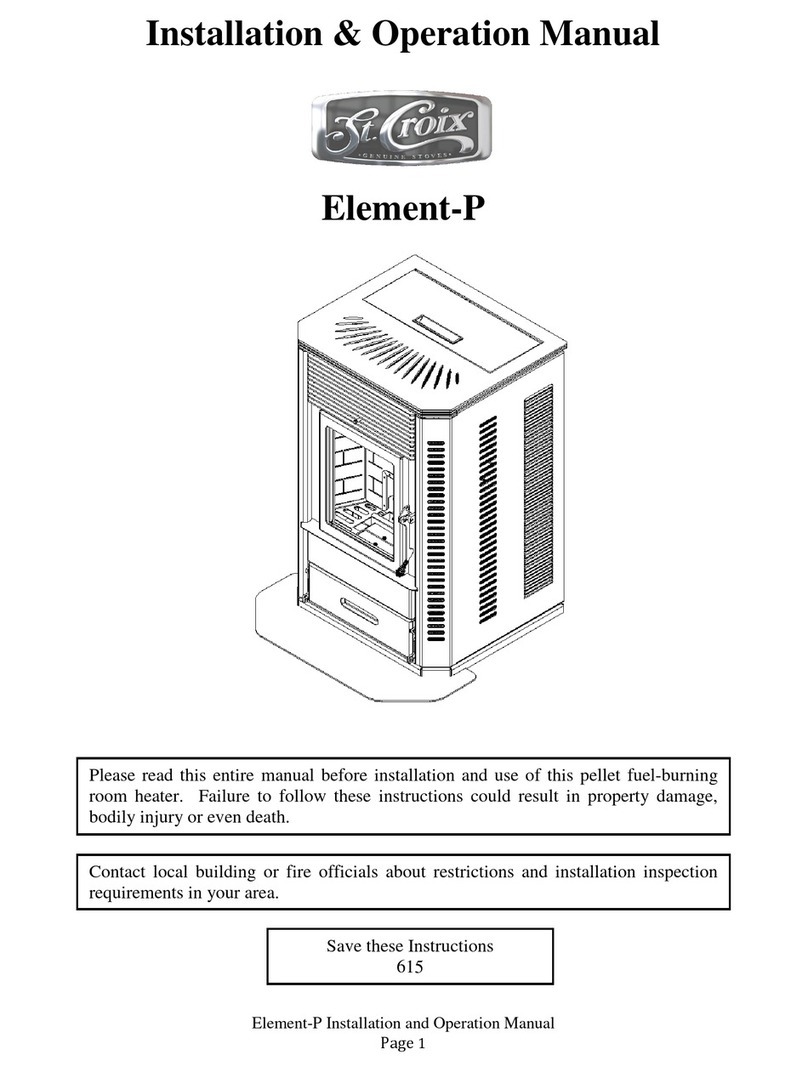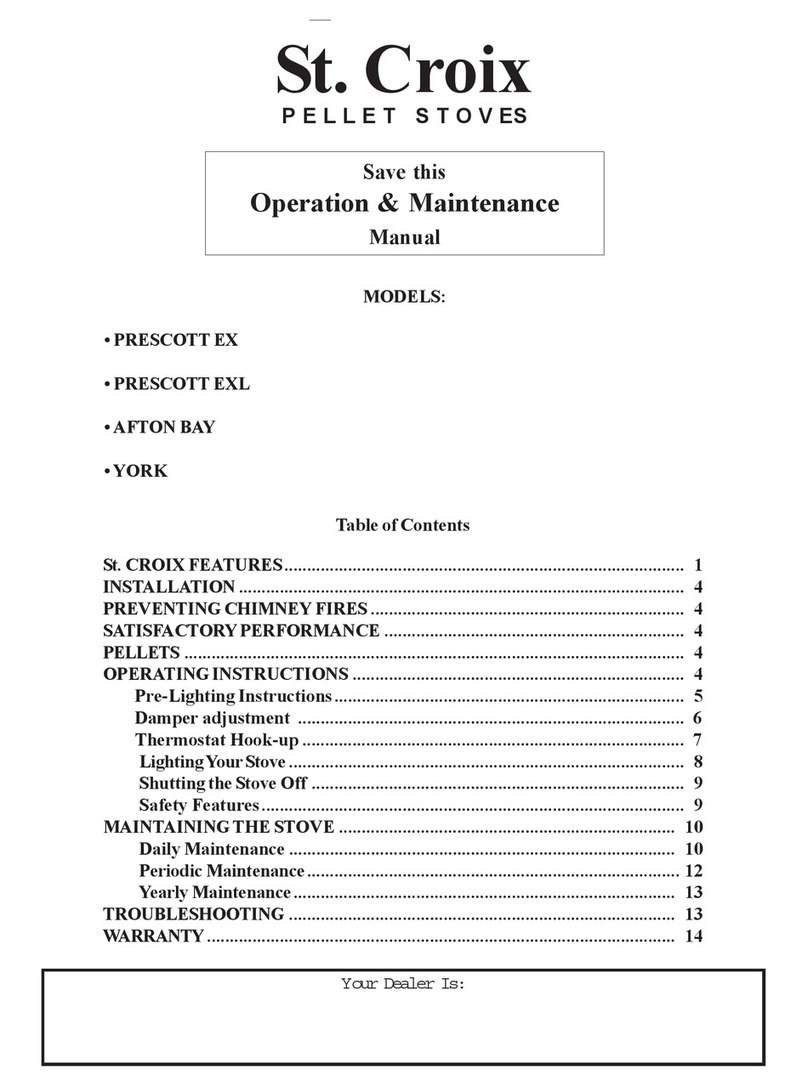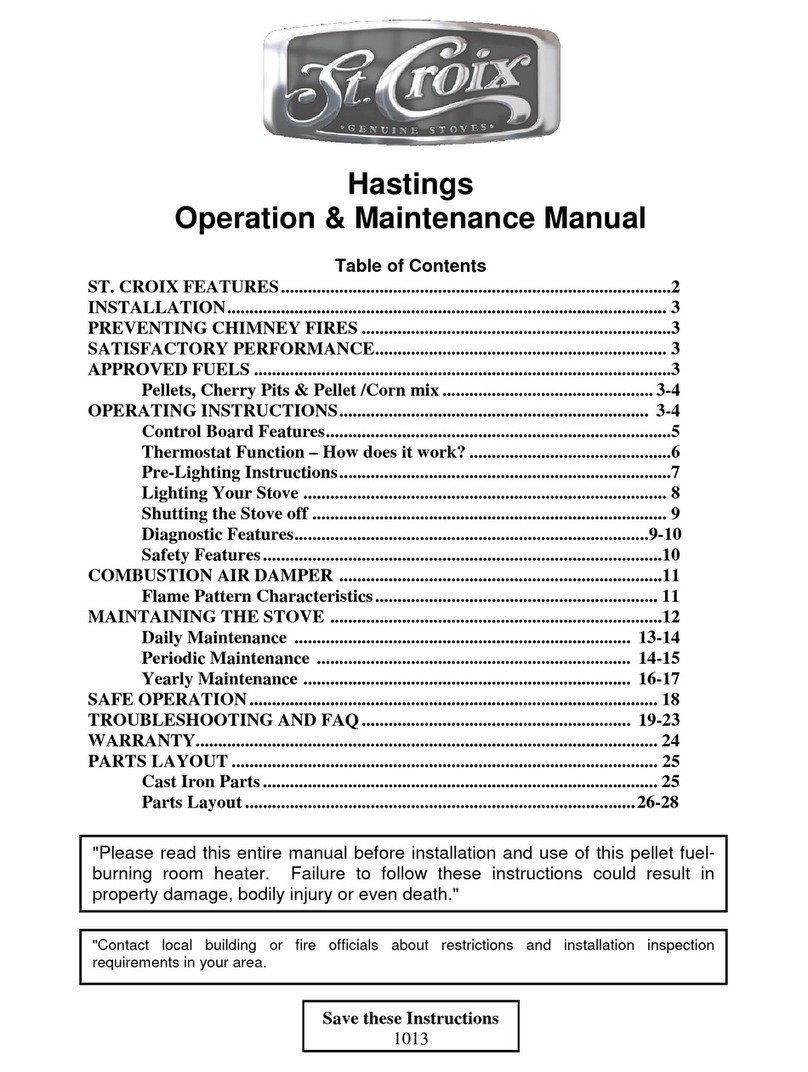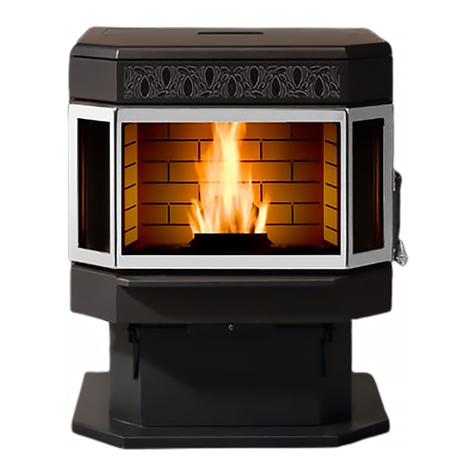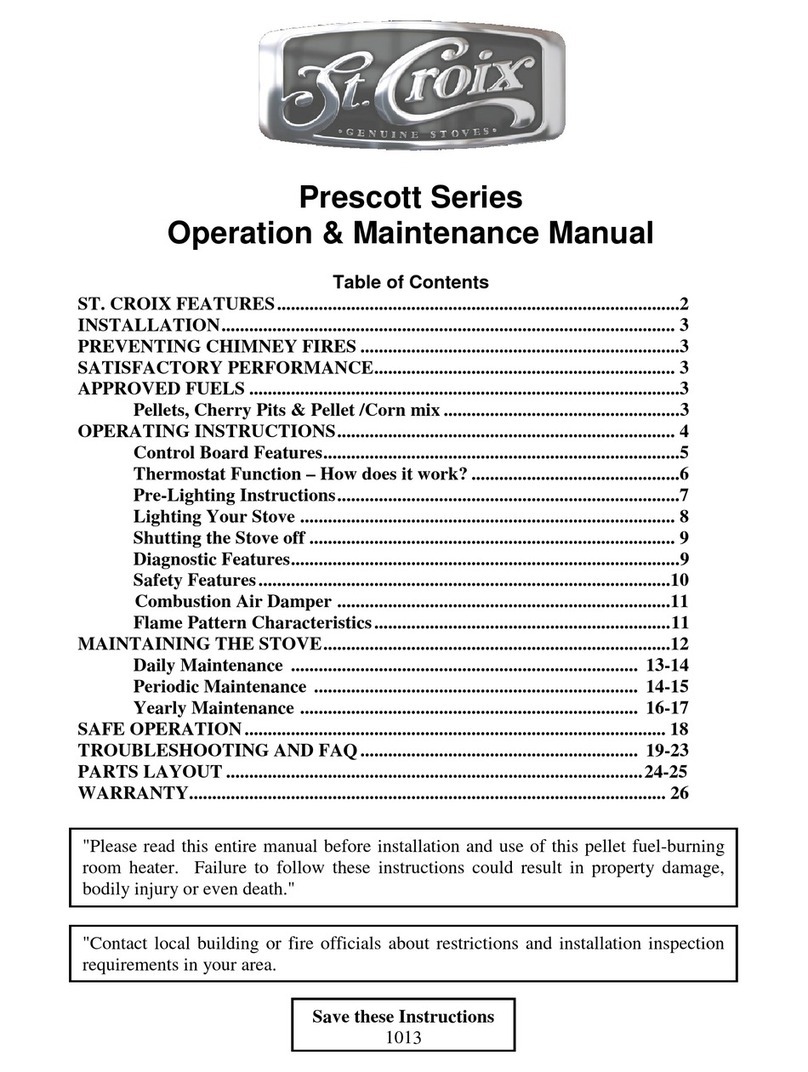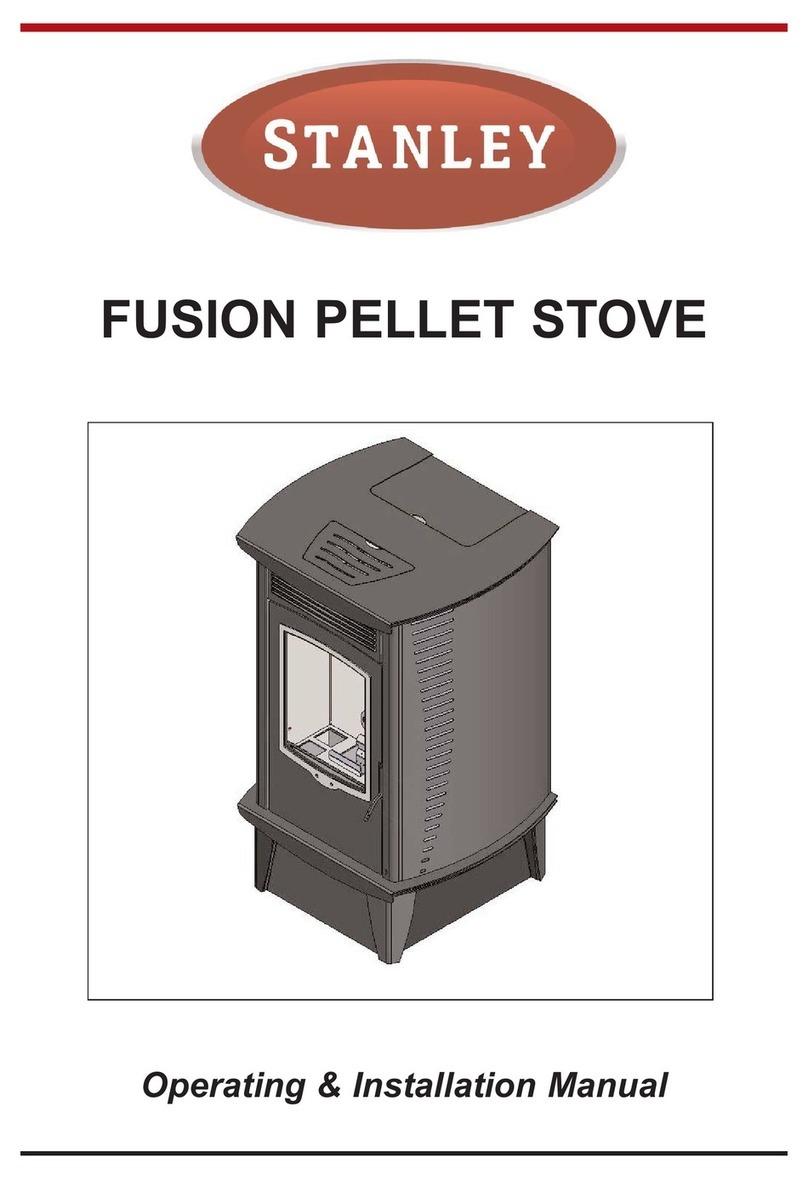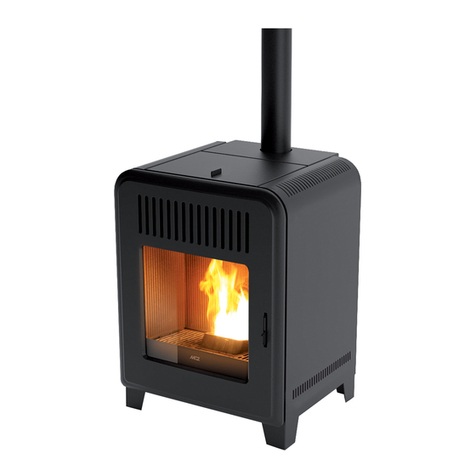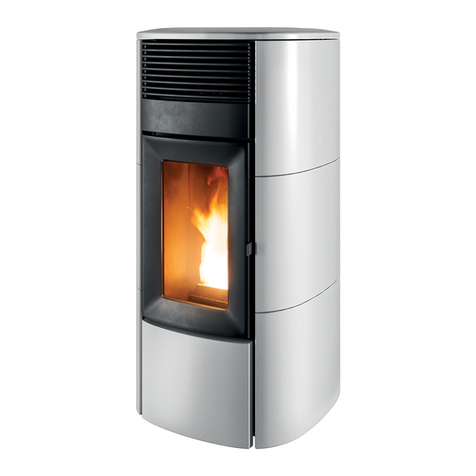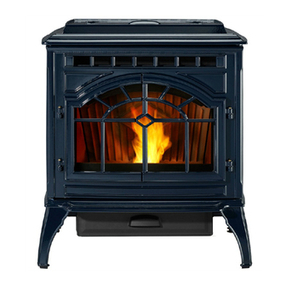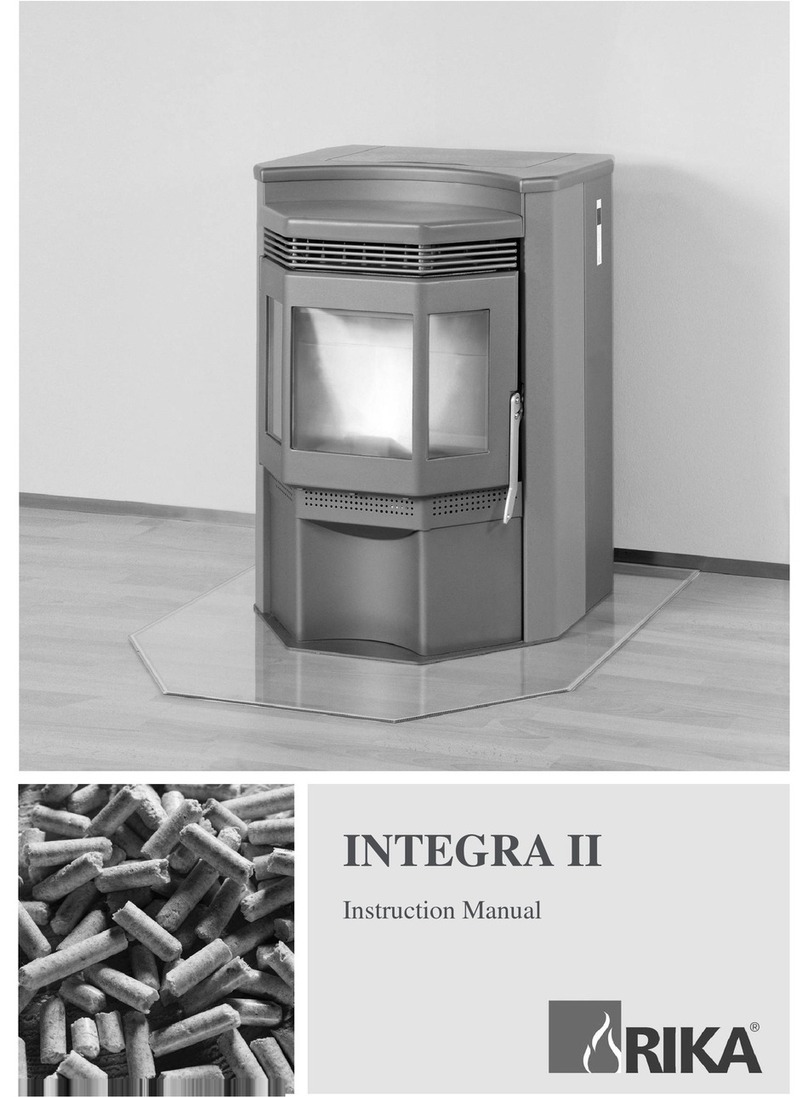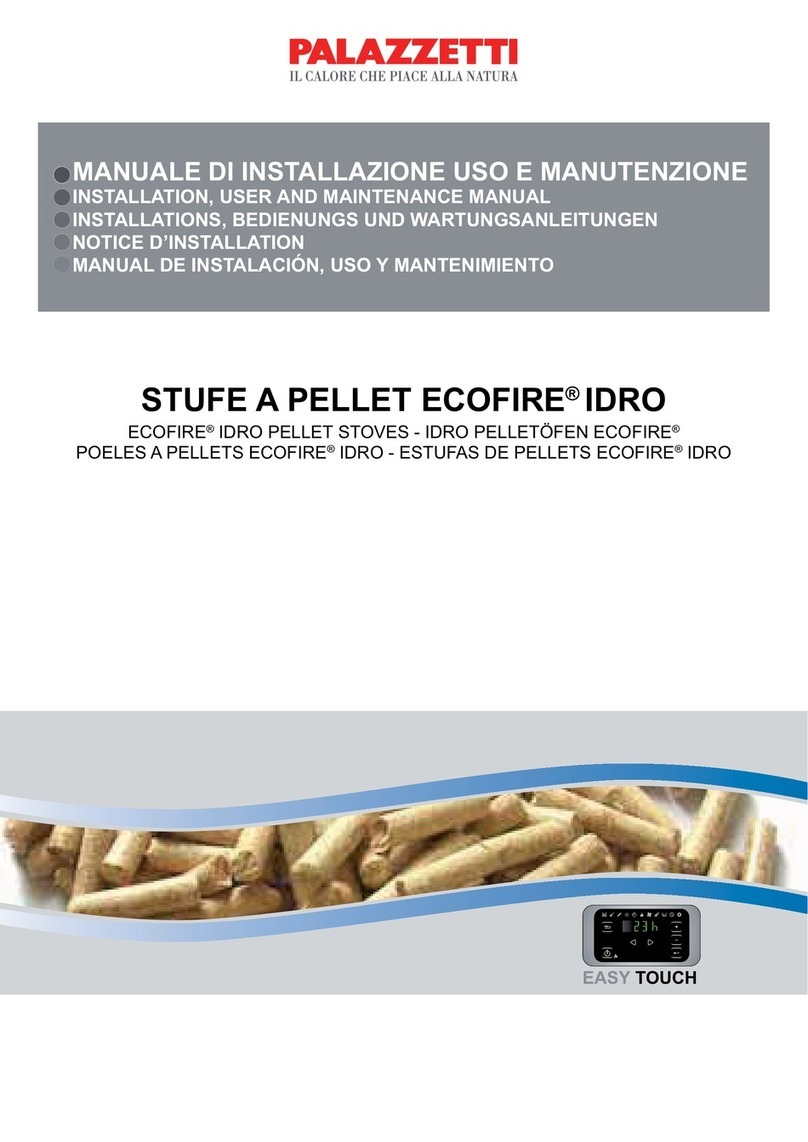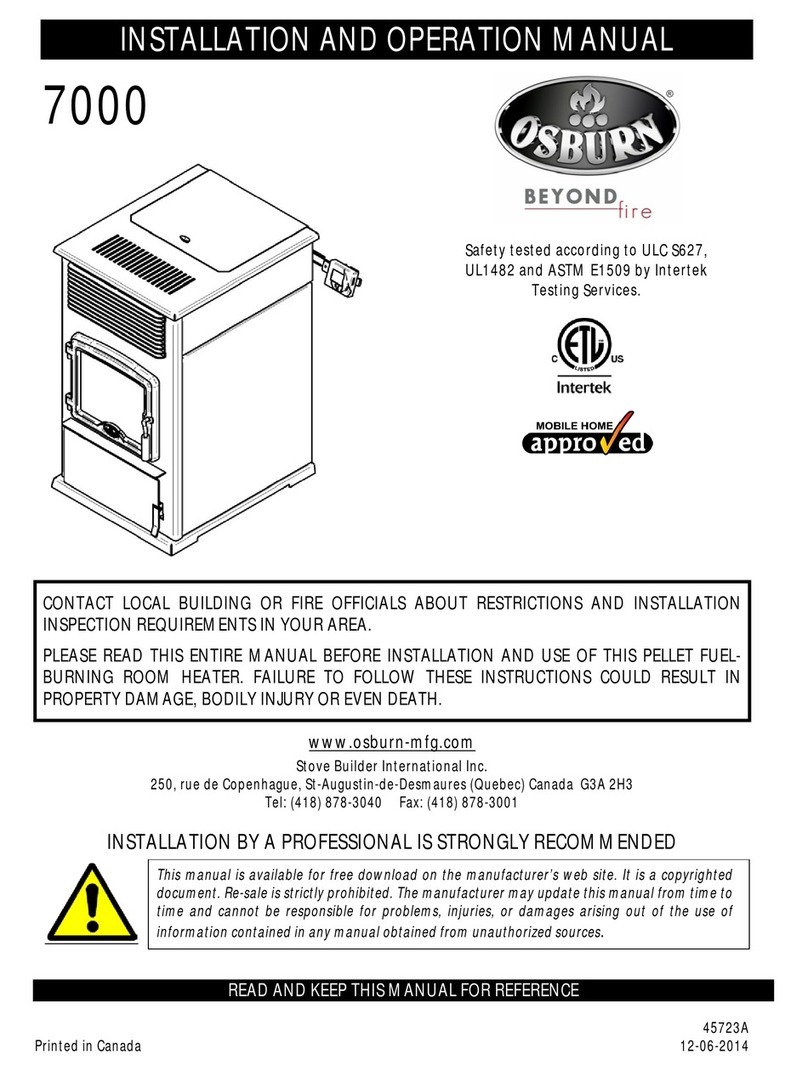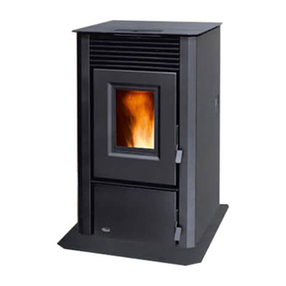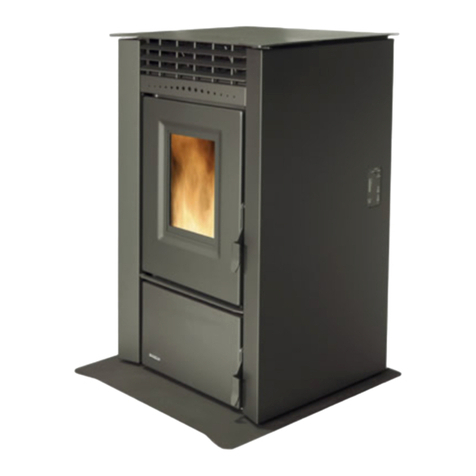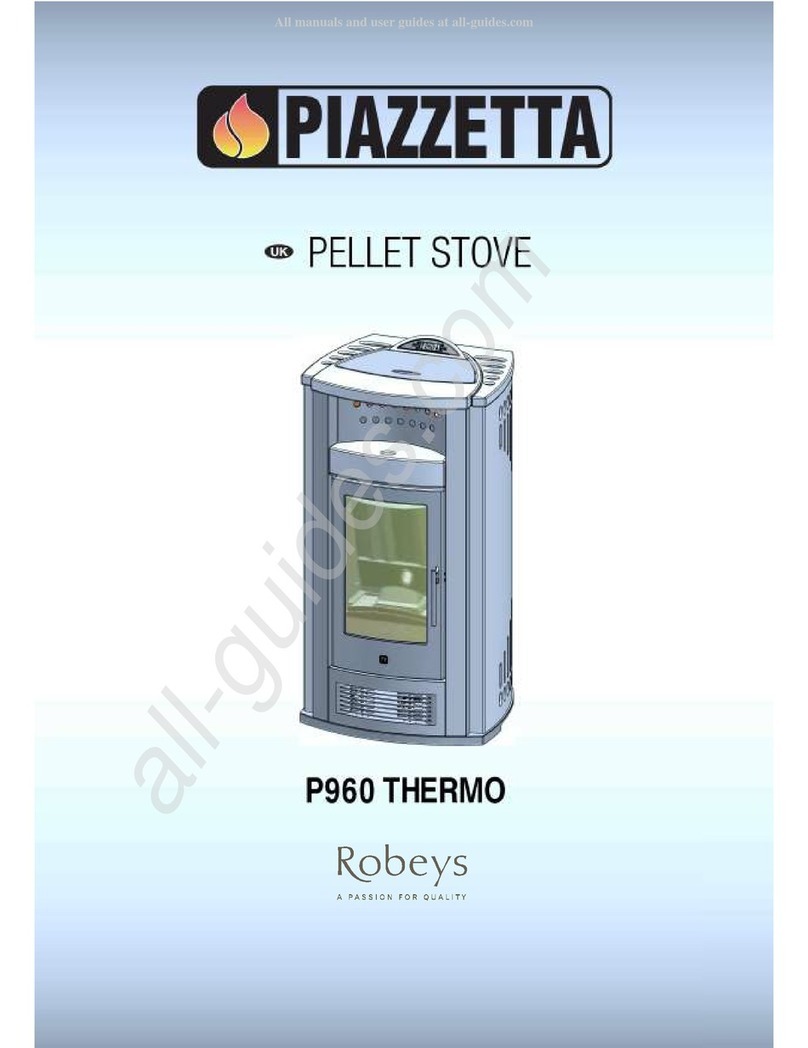St. Croix PRESCOTT EXL Configuration guide

Prescott Series
Operation & Maintenance
Manual
Table of Contents
ST. CROIX FEATURES.......................................................................................2
INSTALLATION.................................................................................................. 3
PREVENTING CHIMNEY FIRES .....................................................................3
SATISFACTORY PERFORMANCE................................................................. 3
APPROVED FUELS .............................................................................................3
Pellets, Cherry Pits & Pellet /Corn mix...................................................3
OPERATING INSTRUCTIONS......................................................................... 4
Control Board Features.............................................................................4
Thermostat Function – How does it work?.............................................5
Pre-Lighting Instructions..........................................................................6
Lighting Your Stove ................................................................................. 6
Shutting the Stove off ............................................................................... 6
Diagnostic Features....................................................................................6
Safety Features...........................................................................................7
Combustion Air Damper ..........................................................................8
Flame Pattern Characteristics..................................................................8
MAINTAINING THE STOVE ............................................................................9
Daily Maintenance ........................................................................... 10-11
Periodic Maintenance ...................................................................... 11-12
Yearly Maintenance ......................................................................... 13-14
SAFE OPERATION........................................................................................... 15
TROUBLESHOOTING AND FAQ............................................................ 16-20
PARTS LAYOUT ..........................................................................................21-22
WARRANTY....................................................................................................... 23
608

Prescott Series Operations Manual
Page 8
THERMOSTAT
WIRE
TERMINAL
DAMPER
Combustion Air Damper
Figure 3
Damper Adjustment
When burning pellets make sure to check for
the formation of creosote in the unit and
venting system. Constantly running the stove
on a low setting with too much combustion air
may cause creosote to form. Burn pot
temperatures can be “too cool” when burning
on low with too much draft.
Adjusting the Damper may take a little time and
patience, but only needs to be done once. After
the damper has been adjusted to the venting
system in your home, the control board will do
the rest.
The purpose of this damper is to adjust
combustion airflow to match the characteristic of
each specific air inlet and chimney configuration.
There is a setscrew in the damper (shown in
Figure 4) and the damper has been preset at the
factory. This setting will most likely work for
90% of the most common installations. Long
horizontal runs might need the damper opened.
Tall vertical runs might need the damper to be
closed a little, etc. To adjust the damper, use the
setscrew to make the adjustments. To make an
adjustment turn the screw ½ turn clockwise to
open the damper or ½ turn counter clockwise to
close the damper. Remember to use the damper
handle to bring the damper up to the screw. The
damper will not close by itself. After making an
adjustment wait at least 15 minutes to see how
the burn pot reacts to the change. Adjusting the
damper during the break in period is very
important (See “Preventing Chimney Fires” on
page 2). Break-in requires the burning of 15 bags of
pellets or continuous burn for two weeks. If during
the initial break-in period you experience difficulty
keeping the stove burning or there appears to be an
excessive amount of burning pellets being evacuated
from the burn grate, it may be necessary to close the
damper some more. Once the damper is fine tuned
for settings 1, 2, 3 and 4 the stove will run fine
without having to make a change to the damper
setting unless the stove is run on 5 for extended
periods of time. It is normal for ash and some sparks
to be continually evacuated from the burn grate. This
is how the grate continuously cleans itself. The
equivalent of a teacup of unburned pellets a day in
the ash pan is considered normal.
Figure 4
Flame Pattern Characteristics
Correct Flame Pattern -
Bright yellowish-white
flame with a brisk movement, having sharp pointed
end tips extending up towards the Heat Exchange
Tubes while forming a fan-like shape. Small
amounts of ash and some live sparks being blown
out from the Burn Pot area is considered normal
operation.
Incorrect Flame Pattern -
Dark orangish-brown
flame with a lazy movement, having black smoky
end tips curling up and over the Heat Exchange
Tubes while forming a fireball-like shape. Some Ash
or Live Sparks not being blown out from the Burn
Pot area is considered abnormal operation.
Extremely black soot forming on the ceramic glass
surface is a sign of very poor combustion (not
enough combustion air) and should not be
overlooked. At the other end of the spectrum; an

Prescott Series Operations Manual
Page 9
extremely brisk flame which blows large pieces
of live coal out from the Burn Pot area and causes
stubborn shiny black build-up on the glass (too
much combustion air) is also considered
undesirable.
If you experience problems
adjusting the stove during the Break-In
Period, contact your dealer.
MAINTAINING THE STOVE - The stove
requires a minimum amount of daily
maintenance. Required maintenance depends
largely upon the quality of pellet fuel burned and
the rate of burn. The amount of daily
maintenance will increase if fuel quality
decreases and/or the burning rate of pellets
increases.
NOTE: FAILURE TO KEEP YOUR STOVE
CLEAN, AS DESCRIBED IN THIS
MANUAL, COULD RESULT IN POOR
OPERATION, INEFFICIENT FUEL
USAGE AND A POSSIBLE SAFETY
HAZARD! IT IS YOUR RESPONSIBILITY
TO DETERMINE NEEDED MAINTE-
NANCE FREQUENCY.
The Versa Grate System (see Figure 5 below).
The benefit of this feature is that the stove can
operate for longer periods of time, with most
fuels, without the grate requiring cleaning. If the
flame becomes dark orange, is accompanied by
black smoke or burns with a lazy motion - it’s time
to clean the grate When you first operate your
stove or whenever you change fuels check to
determine needed cleaning frequency.
First, let’s become familiar with the burn system in
a St. Croix Pellet stove. Remember, cleaning
frequency may change dramatically from one fuel to
another. Pellets with high ash content or that have
increased amounts of impurities or high moisture
content. Every St. Croix Pellet stove model will
have the same system as shown in figure 5 below.
There is a 2-piece burnpot. The top Part is called the
“Grate Weldment”. This sits on top of the “Shaker
Plate”. This in turn sits on top of the “Shaft/Cage
Weldment” and is held in place with the “Spacer”
& “Self Locking Twist pin”. The Shaft/Cage
weldment is moved towards the front of the stove
and then towards the back of the stove by the
“Cam” that is connected to the “Versa Grate
Motor”. This motion is constant, while the stove is
in operation. The only parts that may need to be
removed for cleaning purposes during the Daily or
Periodic Maintenance are the “Grate weldment” and
the “Shaker Plate”. This is to check the holes in the
burnpot system to see if they are plugged.
Figure 5

Prescott Series Operations Manual
Page 10
POT
SCRAPER
ASH
CLEANOUT
ROD
ASH PANROD PULL TOOL
Daily Maintenance
1. Check Grate Weldment and Shaker Plate (See
figure 5) to determine if holes are plugged. Clean
as needed. With proper precautions the grate may
be partially cleaned while the stove is hot. Follow
these steps:
CAUTION: THE
DOOR AND FRONT PART
OF THE STOVE WILL BE HOT. DO NOT
TOUCH ANY PART OF THE STOVE THAT
IS HOT!
a. Wear a leather glove that covers the lower arm.
b. Turn the Stove to Heat Level 1 and allow the
flame to burn down to a low burn.
c. Open the firebox door slowly to prevent
drawing ash or odors into the room.
d. Use the “scraper” provided to move the
burning pellets to one side of the grate, leaving
the ash in the bottom of the grate. (See Fig 5 & 6)
e. Rake the ash & clinkers out over the grate into
the ash pan.
f. Rake the burning pellets across the bottom of
the grate.
g. Close the door.
h. Re-select the desired heat setting.
CAUTION: NEVER ADD FIRE STARTER
TO A HOT STOVE.
Figure 6
2. Remove ash buildup under the grate bottom daily
or as frequently as needed. Clean the ashes out from
under the burn pot by pulling the Ash Cleanout Rod
in and out several times (see Fig. 6) Use the Rod
Pull Tool with the Ash Cleanout Rod. This tool is
hanging on a screw on the back of the stove; this
provides a convenient location to keep the tool in
reach and prevent it from getting lost.
CAUTION: The Ash Cleanout Rod must be
pushed all the way in during operation of the
unit. Failure to keep this area clean could result
in a safety hazard.
3. Check ash pan (See Fig. 6) to determine emptying
frequency needed. NOTE: Do not use a vacuum
cleaner for this purpose. Hot coals may cause your
vacuum filter to catch fire. Place ashes in a metal
container with a tight fitting lid. The closed
container of ashes should be placed on a
noncombustible floor or on the ground, well away
from all combustible materials, pending final
disposal. If the ashes are disposed of by burial in soil
or otherwise locally dispersed, they should be
retained in the closed container for at least two days
until all cinders have thoroughly cooled.
4. Once or twice daily pull the Heat Exchange Tube
Scraper, (See stove layout on page 2) out and back to
clean heat exchange tubes. Failure to operate the
tube scraper daily may result in poor combustion and
loss of heat output. This should be done when the
stove is cool or operating on the low temperature
setting. Use the Rod Pull Tool shown in Figure 6
with the Tube Scraper Rod.
5. The rate of burn and the quality of fuel will
determine how often the window needs cleaning.
Prolonged burning at a slow burn rate will result in
the need for more frequent window cleaning.
Burning poor fuel also increases the need to clean
the window. Cooling the stove and wiping the
window daily with a cloth or paper towel will
normally keep the window from accumulating
difficult to clean residue. Use of a glass cleaner
ONLY permitted when the stove is cold. Tip: Dip
the damp towel in the ashes to remove stubborn
buildup on the glass.
CAUTION: Do not slam the door. Do not
operate the stove with a broken or cracked
glass. Replace only with heat resistant
ceramic glass supplied by the manufacturer.

Prescott Series Operations Manual
Page 11
REMOVE DECORATIVE
GRILL (LEFT SIDE SHOWN)
REMOVE SHIPPING
SCREW & DISCARD
ASH CLEAN-OUT
COVER (LEFT
SIDE SHOWN)
6. Burn the stove at the HI fuel setting for at least
20 to 30 minutes each day. This helps keep the
window, ceraboard and firebox area clean. A
daily high burn also aids in maintaining the
overall efficiency and performance of the stove.
Periodic Maintenance
CAUTION:
Periodic maintenance should only
be done while the stove is shut off and cold.
1. Empty the ash pan when it appears full. This
may range from 1 to 2 weeks in the Prescott
EXP model. The Prescott EXL model has a
much smaller ashpan and should be checked
at least twice a week. The frequency of
cleaning the ash pan will depend on the
quality and amount of pellets being used.
Carefully check to make sure the ash pan
door is tightly closed after each opening.
2. The Prescott models have 3 Exhaust
Cleanout/Ash Trap covers, 2 of which are
located below the rear brick panel and a 3
rd
Clean Out is located behind the Ash Pan.
Remove covers and clean regularly. (See
stoves shown in Figure 7) Be sure to clean
both sides.
Use scraper shown in figure 5 & 6 to scrape
ash into ash pan. Use a vacuum (cold stove
only) to thoroughly clean these areas.
IT IS CRITICAL THAT YOU KEEP ASH CLEAN
OUTS CLEAN FOR SATISFACTORY
PERFORMANCE.
Frequency of cleaning Ash Traps depends on the
amount of fuel being burnt and the quality of the
pellets. Fuel with low ash content is recommended.
Failure to clean the ash traps can cause the stove
to become plugged with fly ash and could result
in a Safety Hazard.
THE LOCATION OF THE THIRD CLEAN-OUT/ASH
TRAP BEHIND THE ASH PAN IN A PRESCOTT EXP
THE LOCATION OF THE THIRD CLEAN-OUT/ASH
TRAP BEHIND THE ASH PAN IN A PRESCOTT EXL
Figure 7

Prescott Series Operations Manual
Page 12
3. Clean burn grate holes at least weekly. Remove
the burn grate and use a small metal object to
clean out plugged holes. (
See fig. 5 on page 9.)
4. Remove the baffle and clean the ashes that
accumulate on a regular basis.
Frequency of cleaning depends on amount of fuel
being burnt and the quality of the pellets. Fuel
with low ash content is recommended.
Failure to clean the baffle can cause the stove
to become plugged with fly ash and could
result in a Safety Hazard.
To remove the baffle (See Figure 8), lift the back
of the baffle up to clear the inner back of the
stove and slide towards the front of the stove. The
baffle will slide out of the keyhole slots and drop
down. When putting the baffle back in the stove,
make sure the screws are in the keyhole slots
and the back of the baffle is lifted up over the
inner back.
4. Periodic cleaning of the exhaust system is
required. Under certain conditions creosote
buildup may occur rapidly. Low quality
pellets and poor installations require more
frequent chimney cleanings. See Page 3
“Preventing Chimney Fires”. The products
of combustion will also contain small
particles of fly ash. The fly ash will collect
in the exhaust vent and restrict the flow of
the flue gases. Judge the frequency of
cleaning by checking the amount of ash that
accumulates in the elbows or tee’s of the
exhaust system. Ask the dealer for suggested
frequency of cleaning, equipment needed
and procedures for cleaning. Check the
exhaust system at least once every two
months during the heating season.
Periodically inspect the condition of the rope
gasket around the door, window and ash door.
Replace as needed.
Figure 8

Prescott Series Operations Manual
Page 13
Yearly Maintenance
Yearly maintenance is designed to assure safe
operation, prolong the life of the stove and help
preserve its aesthetic appeal.
1. Spring Shutdown. After the last burn in the
spring, cool the stove. Remove all pellets
from the hopper and the auger. Thoroughly
clean the burn grate, burn grate box, ash pan
and ash traps behind the ash pan. (To locate
the ash traps see Figure 7 on page 11)
NOTE: UNPLUG THE STOVE. Open the side
panels of the stove. Carefully clean or vacuum
any sawdust, cobwebs and household dust.
Carefully vacuum around the fan motors. If
electrical wires become disconnected call your
dealer for service.
2. The exhaust system should be thoroughly
cleaned at least annually. Call your dealer for
this service.
3. The motor/fan area behind the firebox and under
the hopper should be vacuumed annually.
4. The Exhaust and Room fans should be removed
and cleaned annually. Call dealer for this
service. Annual oiling of the motors is not
needed. (See fig. 8)
Figure 9
Note: The Vacuum Switch may be removed to allow easier access to the combustion fan
This manual suits for next models
1
Other St. Croix Pellet Stove manuals
Popular Pellet Stove manuals by other brands
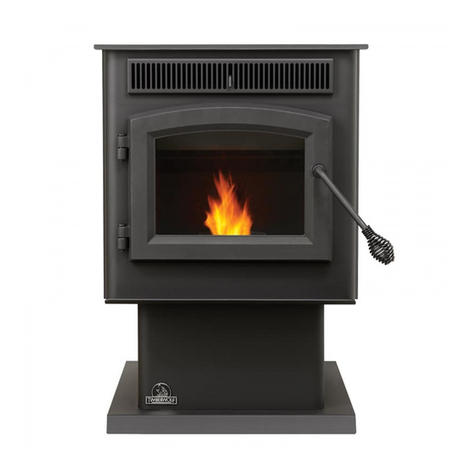
Timberwolf
Timberwolf TPS35 Installation and operating instructions
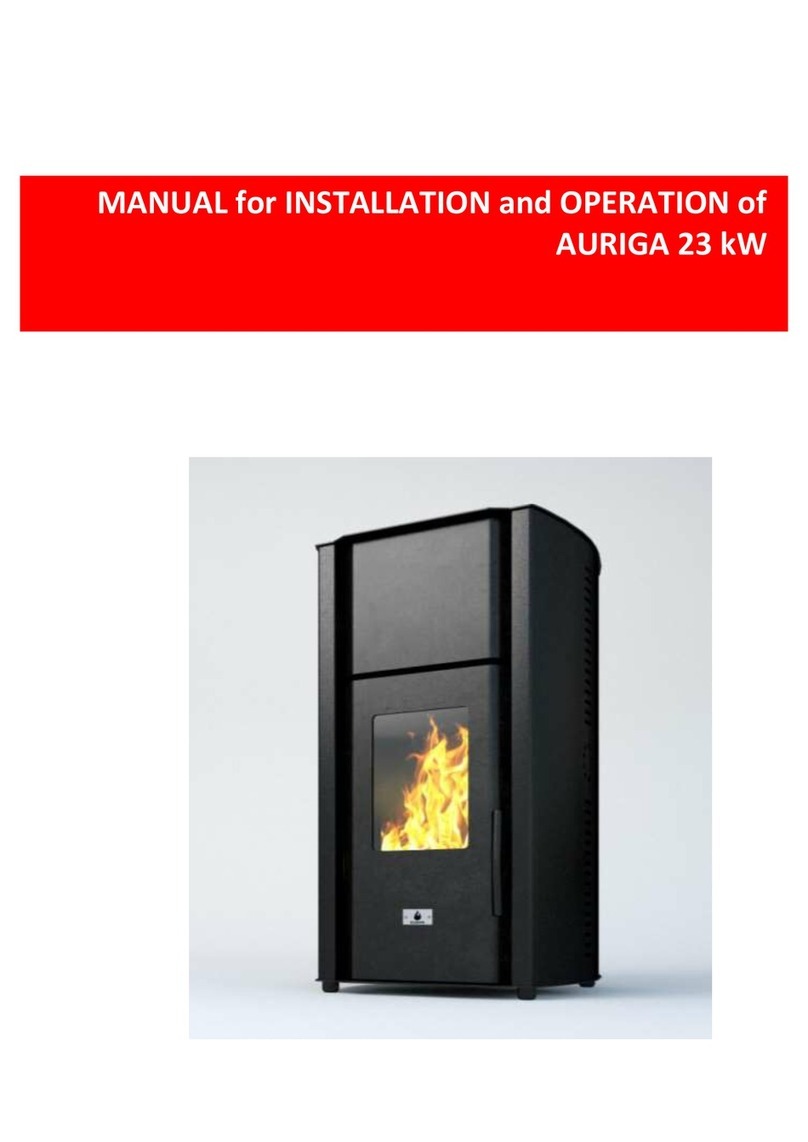
Eco Spar
Eco Spar AURIGA 23 kW Manual for installation and operation
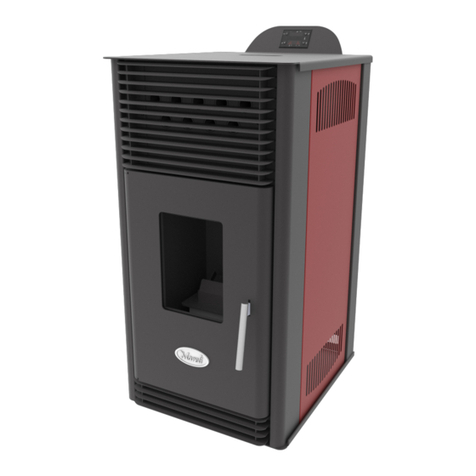
Mareli Systems
Mareli Systems PS 10 Assembly and exploitation manual
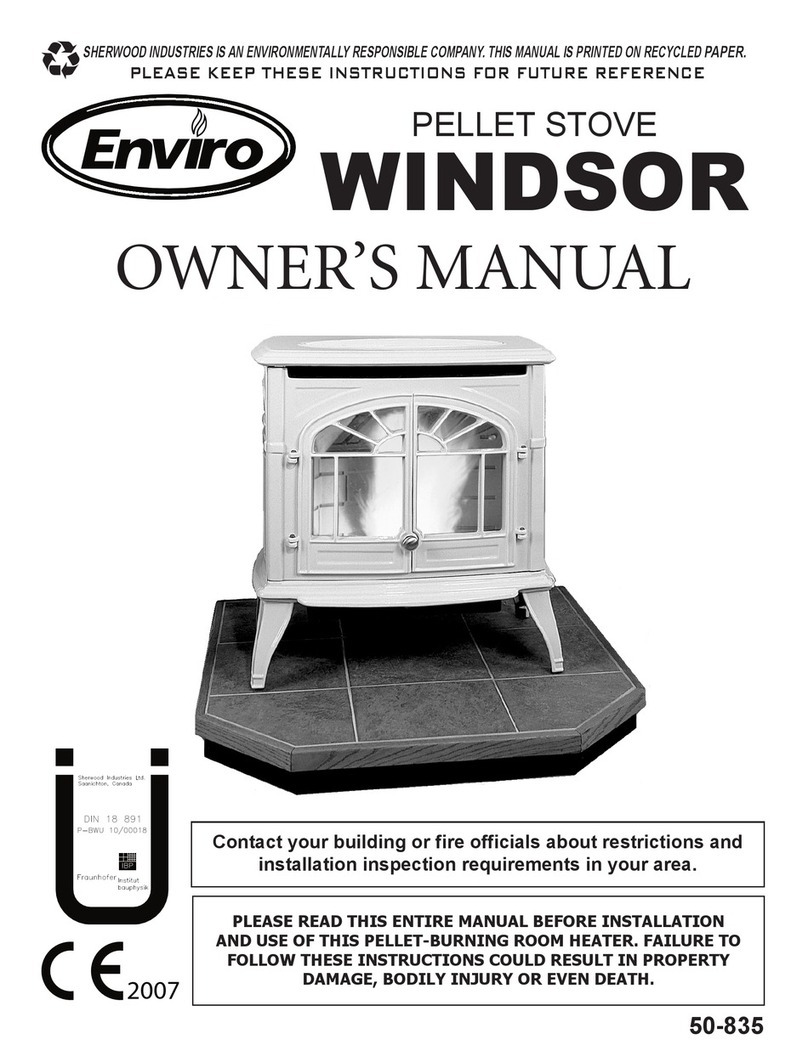
Enviro
Enviro WINDSOR owner's manual
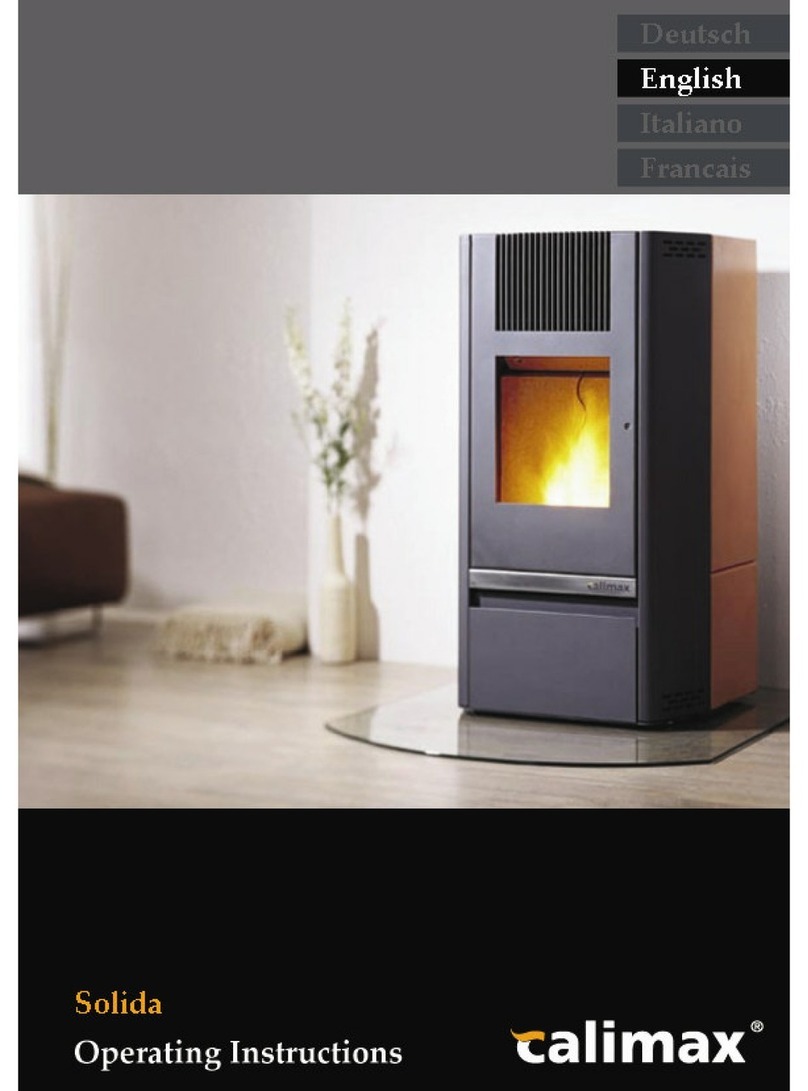
calimax
calimax Solida operating instructions

SMG
SMG ComfortBilt HP21 Operator's manual
